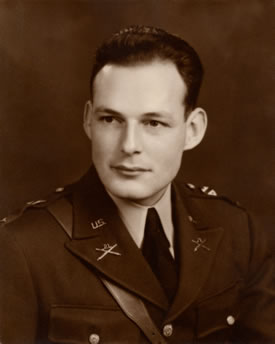Fred Machol
Fred B. Machol (12 June 1916 – 4 October 2010), Lieutenant Colonel U.S. Army
- 13 June 1938, commissioned a 2nd Lieutenant upon graduating from The Ohio State University in Columbus
- 3 March 1940, active duty with the United States Army
- June 1941, promoted to 1st Lieutenant
- January 1942 assumed command 21st Field Artillery B Battery
- April 1942 embarked with B Battery to Iceland Base Command, Reykjavik Iceland
- October 1942 transferred from Field Artillery to Iceland Base Command G-2 Section
- December 1942 promoted to Captain Counter Subversive Officer
- July 1943 promoted to Major
- 18 December 1943, baptized a Roman Catholic and married Lieutenant Mary Louis Payton, U.S. Army nurse
- March 1944 transferred to London to be a Counter Sabotage Officer
- Trained under Lord Victor Rothschild of the British MI5, Commander of all Counter Sabotage in the ETO
- June 1944 transferred to Bristol, England; billeted with the Shuckborrow family in preparation for Operation Overlord
- 12 July landed at Utah Beach, Normandy, France D+36
- October 1944 while stationed in Paris captured German spies
- Late April/early May 1945 delivered counter sabotage kits to units fighting nazis
- Assignments in Metz, Saarbrucken, Mannheim, Augsburg, Heidelberg,
- Munich, Dachau, Berchtesgaden, Obersalzberg, and The Eagles Nest
- While delivering counter sabotage kits to the 5th Division in Volary
- (current Czech Republic), captured by a German SS Totenkomph Division of 3800 men.
- Later that day three P-51 Mustang Fighters flew over convincing the KrautFeldwebel to surrender his luger and say, “Kaput.”
- Captors became prisoners and loaded their helmets, lugers, belt buckles and daggers into the Willys Jeep MBT trailer
- Returned to Paris missing VE-Day by 1 day
- Traded his nazi loot to move his transfer orders to the top of the stack
- Home 21 days after hostilities ended in the ETO
- 29 May 1945 arrived in New York City as military liaison to Hollywood movie director Frank Capra who a producing a counter sabotage training film by request of the government
- Upon completion of the film they walked out of the studio in Times Square where a huge crowd had gathered to celebrate VJ-Day
- Home at last, 123 6th Street Garden City, New York, his war was over.
-
1”
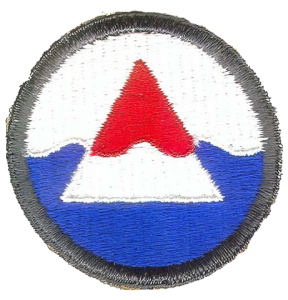 Early in World War II both the British and the Germans had recognized what the Vikings had demonstrated ten centuries before, namely, that Iceland was an important steppingstone between Europe and the New World in North America. Hitler several times toyed with the idea of a descent upon the island and laid preliminary plans for it; but to forestall such a move British troops, soon joined by a Canadian force, had landed in Iceland on 10 May 1940. Icelandic annoyance with the British and Canadian garrison, and British losses in the war, which made a withdrawal of the Iceland garrison seem desirable, plus the United States concern for the Atlantic sea lanes, combined to bring Iceland within the American defense orbit.
Early in World War II both the British and the Germans had recognized what the Vikings had demonstrated ten centuries before, namely, that Iceland was an important steppingstone between Europe and the New World in North America. Hitler several times toyed with the idea of a descent upon the island and laid preliminary plans for it; but to forestall such a move British troops, soon joined by a Canadian force, had landed in Iceland on 10 May 1940. Icelandic annoyance with the British and Canadian garrison, and British losses in the war, which made a withdrawal of the Iceland garrison seem desirable, plus the United States concern for the Atlantic sea lanes, combined to bring Iceland within the American defense orbit. -
2”
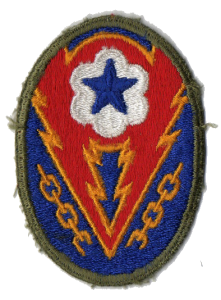 “The Advance Section, Communications Zone”, European Theater of Operations, United States Army, (ETOUSA) which was formally activated at Bristol in February 1944. It is commonly referred to as simply ‘ADSEC’. This was a U.S. Army logistical agency, the first on the Continent. Upon its creation ADSEC was attached to the U.S. First Army, and gradually took over the Communications Zone activities. The agency moved forward with the Armies and provided close support. ADSEC provided detail planning for the invasion of Normandy, D-Day.
“The Advance Section, Communications Zone”, European Theater of Operations, United States Army, (ETOUSA) which was formally activated at Bristol in February 1944. It is commonly referred to as simply ‘ADSEC’. This was a U.S. Army logistical agency, the first on the Continent. Upon its creation ADSEC was attached to the U.S. First Army, and gradually took over the Communications Zone activities. The agency moved forward with the Armies and provided close support. ADSEC provided detail planning for the invasion of Normandy, D-Day.
As such, ASDEC did not have a “base” of operations because this support organization was designed to be on the move continuously. For example, major operations always had a designated “D” day or start date for operations. ADSEC units were moved into operating areas on or several days after a particular “D” day. They stayed until about the D+40, at which time FECOMZ (Forward Echelon, Communications Zone) units would take over. ADSEC units then moved forward to the next “D” location. -
3”21st
 The coat of arms was originally approved for the 21st Field Artillery Regiment on 5 February 1921. It was amended to correct the blazon on 20 May 1921. It was redesignated for the 21st Field Artillery Battalion on 13 December 1940. The insignia was redesignated for the 21st Artillery Regiment on 30 August 1957. Effective 1 September 1971, the insignia was redesignated for the 21st Field Artillery Regiment.
The coat of arms was originally approved for the 21st Field Artillery Regiment on 5 February 1921. It was amended to correct the blazon on 20 May 1921. It was redesignated for the 21st Field Artillery Battalion on 13 December 1940. The insignia was redesignated for the 21st Artillery Regiment on 30 August 1957. Effective 1 September 1971, the insignia was redesignated for the 21st Field Artillery Regiment.World War I: St. Mihiel; Lorraine 1918
World War II: Normandy; Northern France; Rhineland; Ardennes-Alsace; Central Europe
Vietnam: Defense; Counteroffensive; Counteroffensive, Phase II; Counteroffensive, Phase III; Tet Counteroffensive; Counteroffensive, Phase IV; Counteroffensive, Phase V; Counteroffensive, Phase VI; Tet 69/Counteroffensive; Summer-Fall 1969; Winter-Spring 1970; Sanctuary Counteroffensive; Counteroffensive, Phase VII; Consolidation I; Consolidation II; Cease-Fire
Southwest Asia: Defense of Saudi Arabia; Liberation and Defense of Kuwait
War on Terrorism: Campaigns to be determined -
4”Fifth
 The 5th Division was activated as part of United States mobilization in response to the outbreak of European war in the fall of 1939, being formed at Fort McClellan, Alabama under the command of Brigadier General Campbell Hodges. Under the new “triangular” organization, units assigned included:[4]
The 5th Division was activated as part of United States mobilization in response to the outbreak of European war in the fall of 1939, being formed at Fort McClellan, Alabama under the command of Brigadier General Campbell Hodges. Under the new “triangular” organization, units assigned included:[4]
2nd Infantry Regiment
10th Infantry Regiment
11th Infantry Regiment
19th Field Artillery Regiment
7th Engineer Battalion[5]
The following spring, in 1940, the division was sent to Fort Benning, Georgia, and then temporarily to Louisiana for training exercises, before being transferred to Fort Benjamin Harrison at the end of May 1940. That December the division relocated to Fort Custer, Michigan, from where it participated in the Tennessee maneuvers. The formation went next to Camp Joseph T. Robinson, Arkansas, in August 1941 for staging into both the Arkansas and Louisiana maneuvers before returning to Fort Custer that October. The division was stationed at Fort Custer when the Japanese attacked Pearl Harbor and the United States declared war during December 1941. As the winter passed the division was brought up to strength and fully equipped for forward deployment into a war zone. During April 1942, the 5th Division received its overseas orders and departed the New York Port of Embarkation at the end of the month for Iceland. The division debarked in Iceland in May 1942, where it replaced the British garrison on this island outpost along the Atlantic convoy routes, and a year later was reorganized and re-designated as the 5th Infantry Division on 24 May 1943 -
5”Field
 The Field Artillery is one of the Army’s combat arms, traditionally one of the three major branches (with Infantry and Armor). It refers to those units that use artillery weapons systems to deliver surface-to-surface long range indirect fire. Indirect fire means that the projectile does not follow the line of sight to the target. Mortars are not field artillery weapons; they are organic to infantry units and are manned by infantry personnel.
The Field Artillery is one of the Army’s combat arms, traditionally one of the three major branches (with Infantry and Armor). It refers to those units that use artillery weapons systems to deliver surface-to-surface long range indirect fire. Indirect fire means that the projectile does not follow the line of sight to the target. Mortars are not field artillery weapons; they are organic to infantry units and are manned by infantry personnel.
The term field artillery is to distinguish from the Air Defense Artillery, and historically, from the U.S. Army Coast Artillery Corps (or Coastal Defense Artillery), a branch which existed from 1901–1950. In 1950, the two branches were unified and called simply Artillery, until Air Defense Artillery was made into a separate branch in 1968. The insignia of the Field Artillery branch is a pair of crossed field guns (19th century style cannons) in gold, and dates back to 1834.
The officially stated mission of the Field Artillery is to destroy, neutralize, or suppress the enemy by cannon, rocket, and missile fire and to help integrate all fire support assets into combined arms operations.
The home of the Field Artillery and the Field Artillery School are at Fort Sill, Oklahoma.
then-Captain Harry S Truman in 1918-the only “redleg” to become President
Field artillery is called the “King of Battle”. Conflicts in the 20th century saw artillery become exponentially more effective as indirect fire methods were introduced immediately prior to World War I. During World War I and World War II, field artillery was the single highest casualty-producing weapons system on any battlefield.
Members of the Field Artillery are referred to as “redlegs” because during the American Civil War they were distinguished by scarlet stripes down the legs of their uniform pants. The use of colors to distinguish branches of the United States Army dates to 1851. Branch colors are found on the shoulder straps of officers wearing the blue dress uniform and on branch of service scarves authorized for wear with a variety of uniforms.[1] -
6”Expert
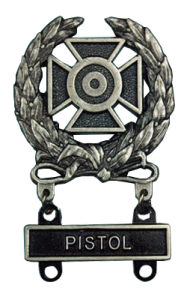 A Marksmanship Badge is a military badge of the United States Armed Forces or a U.S. Civilian badge which is presented to personnel upon successful completion of a weapons qualification course (known as Marksmanship Qualification Badges) or high placement in an official marksmanship competition (known as Marksmanship Competition Badges). The U.S. Military’s and Civilian Marksmanship Program’s (CMP) Marksmanship Qualification Badges are awarded in three grades (highest to lowest): Expert, Sharpshooter, and Marksman while their Marksmanship Competition Badges are typically awarded in gold, silver, and bronze or silver and bronze (service dependent). The National Rifle Association’s (NRA) Marksmanship Qualification Badges are awarded in six grades (highest to lowest): Distinguished Expert, Expert, Sharpshooter, Marksman First-Class, Marksman, and Pro-Marksman. The NRA’s Marksmanship Competition Badges are only awarded at one level (gold) with the exception of their Law Enforcement Distinguished Program which starts with the silver Excellence-in-Competition Badge and ends with the awarding of a Law Enforcement Distinguished Pistol Badge.
A Marksmanship Badge is a military badge of the United States Armed Forces or a U.S. Civilian badge which is presented to personnel upon successful completion of a weapons qualification course (known as Marksmanship Qualification Badges) or high placement in an official marksmanship competition (known as Marksmanship Competition Badges). The U.S. Military’s and Civilian Marksmanship Program’s (CMP) Marksmanship Qualification Badges are awarded in three grades (highest to lowest): Expert, Sharpshooter, and Marksman while their Marksmanship Competition Badges are typically awarded in gold, silver, and bronze or silver and bronze (service dependent). The National Rifle Association’s (NRA) Marksmanship Qualification Badges are awarded in six grades (highest to lowest): Distinguished Expert, Expert, Sharpshooter, Marksman First-Class, Marksman, and Pro-Marksman. The NRA’s Marksmanship Competition Badges are only awarded at one level (gold) with the exception of their Law Enforcement Distinguished Program which starts with the silver Excellence-in-Competition Badge and ends with the awarding of a Law Enforcement Distinguished Pistol Badge.
The United States Army issues Marksmanship Qualification Badges for a variety of weapons while the United States Marine Corps only issues Marksmanship Qualification Badges for rifle and pistol, and the NRA for rifle, shotgun, and pistol. -
7”Prisoner
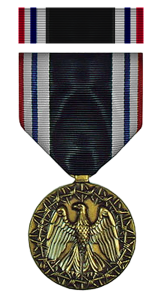 The Prisoner of War Medal is a military award of the United States armed forces which was authorized by Congress and signed into law by President Ronald Reagan on 8 November 1985. The United States Code citation for the POW Medal statute is 10 U.S.C. § 1128.
The Prisoner of War Medal is a military award of the United States armed forces which was authorized by Congress and signed into law by President Ronald Reagan on 8 November 1985. The United States Code citation for the POW Medal statute is 10 U.S.C. § 1128.
The Prisoner of War Medal may be awarded to any person who was a prisoner of war after April 5, 1917 (the date of the United States’ entry into World War I was April 6). It is awarded to any person who was taken prisoner or held captive while engaged in an action against an enemy of the United States; while engaged in military operations involving conflict with an opposing Armed Force; or while serving with friendly forces engaged in armed conflict against an opposing Armed Force in which the United States is not a belligerent party. As of an amendment to Title 10 of the United States Code in 2013, the medal is also awarded for captivity under circumstances “which the Secretary concerned finds were comparable to those circumstances under which persons have generally been held captive by enemy armed forces during periods of armed conflict.”[3] The person’s conduct, while in captivity, must have been honorable. This medal may be awarded posthumously to the surviving next of kin of the recipient.
No more than one Prisoner of War Medal may be awarded. For any subsequent award of the medal, service stars will be awarded and worn on the suspension and service ribbon of the medal. -
8”American
 The medal was established June 28, 1941 by President Franklin Roosevelt, in Executive Order 8808.
The medal was established June 28, 1941 by President Franklin Roosevelt, in Executive Order 8808.
A similar decoration, known as the American Campaign Medal was created in 1942 for wartime service within the borders of the United States of America.
For various periods since 1953, retroactive to 1950, the National Defense Service Medal has been awarded with criteria similar to that of the American Defense Service Medal. -
9”American
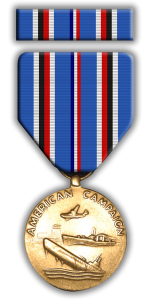
The American Campaign Medal was a military award of the United States Armed Forces which was first created on November 6, 1942 by Executive Order 9265 issued by President Franklin D. Roosevelt. Originally issued as the “American Theater Ribbon”, the medal was intended to recognize those service members who had performed duty in the American Theater of Operations during World War II. A similar medal, known as the American Defense Service Medal existed for American defense service prior to the United States entry into World War II.
The requirements for the American Campaign Medal were: a service member was required to either perform one year of duty (cumulative) within the continental borders of the United States, or perform 30 days consecutive or 60 non-consecutive days of duty outside the borders of the United States but within the American Theater of Operations. The American Theater was defined as the entirety of the United States to include most of the Atlantic Ocean, a portion of Alaska, and a small portion of the Pacific bordering California and Baja California.[1] \
The eligibility dates of the American Campaign Medal were from December 7, 1941 to March 2, 1946. Service stars were authorized to any service member who was engaged in actual combat with Axis forces within the American theater. This primarily applied to those members of the military which had engaged in anti-U-Boat patrols in the Atlantic.[2]
The first recipient of the American Campaign Medal was General of the Army George C. Marshall.[3] -
10”European
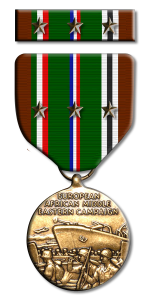
The European-African-Middle Eastern Campaign Medal is a military award of the United States Armed Forces which was first created on November 6, 1942 by Executive Order 9265 [1] issued by President Franklin D. Roosevelt. The medal was intended to recognize those military service members who had performed military duty in the European Theater (to include North Africa and the Middle East) during the years of the Second World War. Colored bands representing Germany (on the ribbon’s left side), Italy (on the ribbon’s right side), and the United States (in the center of the ribbon) are visible in the ribbon. The brown and green areas of the ribbon represent the terrain of the area of conflict, which ranged from beaches and sand, to grass and woodlands, to mountains.
Originally known as the “EAME Ribbon”, the European-African-Middle Eastern Campaign Medal is awarded for any service performed between December 7, 1941 and March 2, 1946 provided such service was performed in the geographical theater areas of Europe, North Africa, or the Middle East. For those service members who participated in one or more military campaigns, Service stars are authorized to be worn on the medal. The Arrowhead device is also authorized to be worn on the medal for those who participated in airborne or amphibious assault landings; the Fleet Marine Force Combat Operation Insignia is also authorized for wear on the medal for sailors attached to the Marine Corps. -
11”Victory
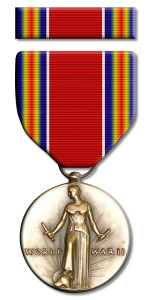 The World War II Victory Medal is a campaign medal of the United States military which was created by an act of Congress in July 1945. The medal commemorates military service during World War II and is awarded to any member of the United States military, including members of the armed forces of the Government of the Philippine Islands, who served on active duty, or as a reservist, between December 7, 1941 and December 31, 1946.
The World War II Victory Medal is a campaign medal of the United States military which was created by an act of Congress in July 1945. The medal commemorates military service during World War II and is awarded to any member of the United States military, including members of the armed forces of the Government of the Philippine Islands, who served on active duty, or as a reservist, between December 7, 1941 and December 31, 1946.
The World War II Victory Medal was first issued as a service ribbon referred to as the “Victory Ribbon.” By 1946, a full medal had been established which was referred to as the World War II Victory Medal. The medal’s front depicts Nike standing victorious, holding a broken sword, representing the broken power of the Axis, with one foot upon the helmet of Mars, the Roman god of war, representing the end of the conflict. Behind Nike is a sunburst, representing the dawn of peace. The reverse recalls the “Four Freedoms” speech by President Roosevelt, with a laurel sprig, surrounded by the words “United States of America”, and the dates of formal US participation in the conflict, “1941-1945″. The edges of the suspension and service ribbon of the medal revisit the corresponding multicolored rainbow ribbons of the Allied World War I Victory Medal. This again honors all the allied nations. The wide red center represents the new sacrifice of blood by World War II combatants. The thin white lines separating the central red band from the outer multicolored bands represent the rays of new hope, two of them signifying that this was the second global conflict.
There is no minimum service time limit for the issuance of the World War II Victory Medal, and the National Personnel Records Center has reported some cases of service members receiving the award for simply a few days of service. As the Second World War ended on September 2, 1945, there are also cases of service members, who had enlisted in 1946, receiving the medal without having been a veteran of World War II. The reason for this late date is that President Harry S. Truman did not declare an official end of hostilities until the last day of 1946. -
12”Legion
 The Legion of Honour, full name National Order of the Legion of Honour, is the highest French order for military and civil merits, established 1802 byNapoléon Bonaparte.
The Legion of Honour, full name National Order of the Legion of Honour, is the highest French order for military and civil merits, established 1802 byNapoléon Bonaparte.
Fred Machol
